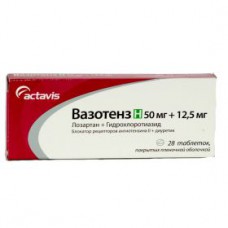Expiration date: 06/2026
Release form, composition
Tablets, film-coated white color, round, lenticular, scored on two sides of the tablet and side risks, with marking "LH" on the one hand from the risks and "2" on the other side of the risks.
In 1 tablet:
losartan potassium 50 or 100 mg
hydrochlorothiazide 12.5 or 25 mg
Auxiliary substances: mannitol - 165 mg, microcrystalline cellulose - 80 mg croscarmellose sodium - 16 mg, povidone - 8 mg magnesium stearate 6 mg, Opadry white - 6 mg (hypromellose 3cP - 2.8 mg, hydroxypropyl cellulose - 2.4 mg titanium dioxide 1.6 mg, macrogol - 0.8 mg, hypromellose 50cP - 0.4 mg).
Pharmacological action.
Combined preparation has anti-hypertensive effects. Contains losartan potassium is an antagonist of the angiotensin II receptor (AT1 subtype), and hydrochlorothiazide is a diuretic.
Losartan is a specific antagonist of angiotensin II receptors (subtype AT1). Does not inhibit kinase II, the enzyme that destroys bradykinin. Reduces the total peripheral resistance (systemic vascular resistance), blood concentration of epinephrine and aldosterone, blood pressure (BP), the pressure in the pulmonary circulation; reduces afterload, has a diuretic effect. Prevents the development of myocardial hypertrophy, increases tolerance to physical load in patients with chronic heart failure.
Hydrochlorothiazide – thiazide diuretic. It reduces the reabsorption of sodium ions, increases the excretion of potassium ions, bicarbonate and phosphate. Lowers AD by reducing the volume of circulating blood (BCC), changes in reactivity of the vascular wall, reduction of the Pressor effect of vasoconstrictor agents and enhance the depressant effect on the ganglia.
Pharmacokinetics.
Losartan is rapidly absorbed from the gastrointestinal tract. Bioavailability is about 30%. Undergoes first pass effect through the liver, metabolised by carboxylation with the formation of active metabolite. Relationship with blood plasma proteins – 99%. Tmax in plasma of losartan is about 1 h, active metabolite – 3-4 h after ingestion.
T1/2 - 1.5–2 h, and its main metabolite - 3-4 h, respectively. About 35% of the dose is excreted in the urine, about 60% - through the intestines.
Hydrochlorothiazide is rapidly absorbed from the gastrointestinal tract.
T1/2 is 5.8-14.8 h is Not metabolized by the liver. About 61% is excreted by the kidneys unchanged.
Testimony
Arterial hypertension (in patients for whom combination therapy is optimal).
Dosage.
Inside, regardless of meals.
Usual starting and maintenance dose is 50 mg losartan/12.5 mg hydrochlorothiazide (1 tab.) a day. For those patients in whom this dose fails to achieve adequate control of blood pressure, the dose may be increased to 2 tab. (50 mg/12.5 mg) or 1 tab. (100 mg/25 mg) 1 times/day. The maximum dose is 2 tablets. (50 mg/12.5 mg) or 1 tab. (100 mg/25 mg) 1 times/day.
In General, the maximum hypotensive effect is achieved within 3 weeks after the start of treatment.
No need for special selection of the initial dose in elderly patients.
Overdose.
Symptoms caused by overdose of losartan: expressed lower AD, tachycardia, bradycardia (caused by vagal stimulation).
Symptoms caused by overdose of hydrochlorothiazide: loss of electrolytes (hypokalemia, hyperchloremia, hyponatremia) and dehydration resulting from excessive diuresis.
Treatment: symptomatic and supportive therapy. If the drug passed recently, you should wash out the stomach; if necessary, a correction of water-electrolyte disorders.
Losartan and its active metabolite are not removed with hemodialysis.
Drug interactions
Losartan enhances the effect of other antihypertensive agents. Not clinically significant interactions with hydrochlorothiazide, digoxin, indirect antikoagulyantami, cimetidine, phenobarbital, ketoconazole, erythromycin. There are reports that rifampicin fluconazole and reduce the level of active metabolite. The clinical significance of these interactions has not been studied.
Like other drugs that block angiotensin II or its effect, the simultaneous appointment kalisberegath dioretikov (for example, spironolactone, triamterene, amiloride), potassium supplements or salt substitutes containing potassium may lead to hyperkalemia.
NSAIDs, including selective cyclooxygenase-2 inhibitors can reduce the effect of diuretics and other antihypertensive agents.
In some patients with compromised renal function who received therapy with NSAIDs (including COX-2 inhibitors), treatment with the receptor antagonists of angiotensin II can cause further deterioration of renal function, including acute renal failure, which is usually reversible.
Hypotensive effect of losartan, and other antihypertensive drugs may be impaired when taking indomethacin.
Hydrochlorothiazide.
The following drugs may interact with thiazide diuretics at simultaneous appointment with them:
Barbiturates, narcotics, ethanol may potentiate orthostatic hypotension.
Hypoglycemic drugs (oral agents and insulin) may require dosage adjustment of hypoglycemic agents.
Other antihypertensive drugs - additive effect possible.
Cholestyramine and colestipol reduce the absorption of hydrochlorothiazide.
Corticosteroids, ACTH - increased loss of electrolytes, especially potassium.
Pressor amines - a slight decrease in the effect of Pressor amines, do not interfere with their use.
Non-depolarizing muscle relaxants (e.g., tubocurarine chloride) - may increase the action of muscle relaxants.
Lithium drugs - diuretics reduce kidney klirens lithium and increase the risk of lithium toxicity, therefore concurrent use is not recommended.
NSAIDs, including selective COX-2 inhibitors: may decrease diuretic, natriuretic and antihypertensive effect of diuretics.
Effect on laboratory results.
Due to the effect on calcium excretion, thiazides may influence the results of the analysis of the function of the parathyroid glands.
Pregnancy and lactation.
Contraindicated during pregnancy and lactation.
Taking drugs, directly influencing the system, the renin/angiotensin during II and III trimesters of pregnancy can lead to fetal death. In the event of pregnancy shows removal of the drug.
Pregnant women the use of diuretics are usually not recommended due to risk of jaundice in the fetus and newborn, thrombocytopenia mother. Therapy diuretics does not prevent development of toxemia of pregnancy.
Side effects.
Limited to adverse reactions previously observed with the use of losartan potassium and/or hydrochlorothiazide.
The most common side effects in the treatment of essential hypertension include dizziness.
Allergic reactions: anaphylactoid reactions, angioedema including swelling of the larynx and/or tongue that lead to airway obstruction and/or swelling of the face, lips, pharynx and/or tongue, occasionally observed while taking losartan. Some of these patients previously had angioedema with other drugs including ACE inhibitors. Very rarely while taking losartan the phenomena of vasculitis, including disease Shenleyn-Schonlein purpura.
From the side of cardiovascular system: decrease in blood pressure.
From the digestive tract while taking losartan were was rare (1%) cases of hepatitis, diarrhea.
From the side of respiratory system: when you receive losartan cough.
With the skin: urticaria.
From the laboratory parameters: rare (1 %) - hyperkalemia (serum potassium more than 5.5 mmol/l), increased activity of liver enzymes.


